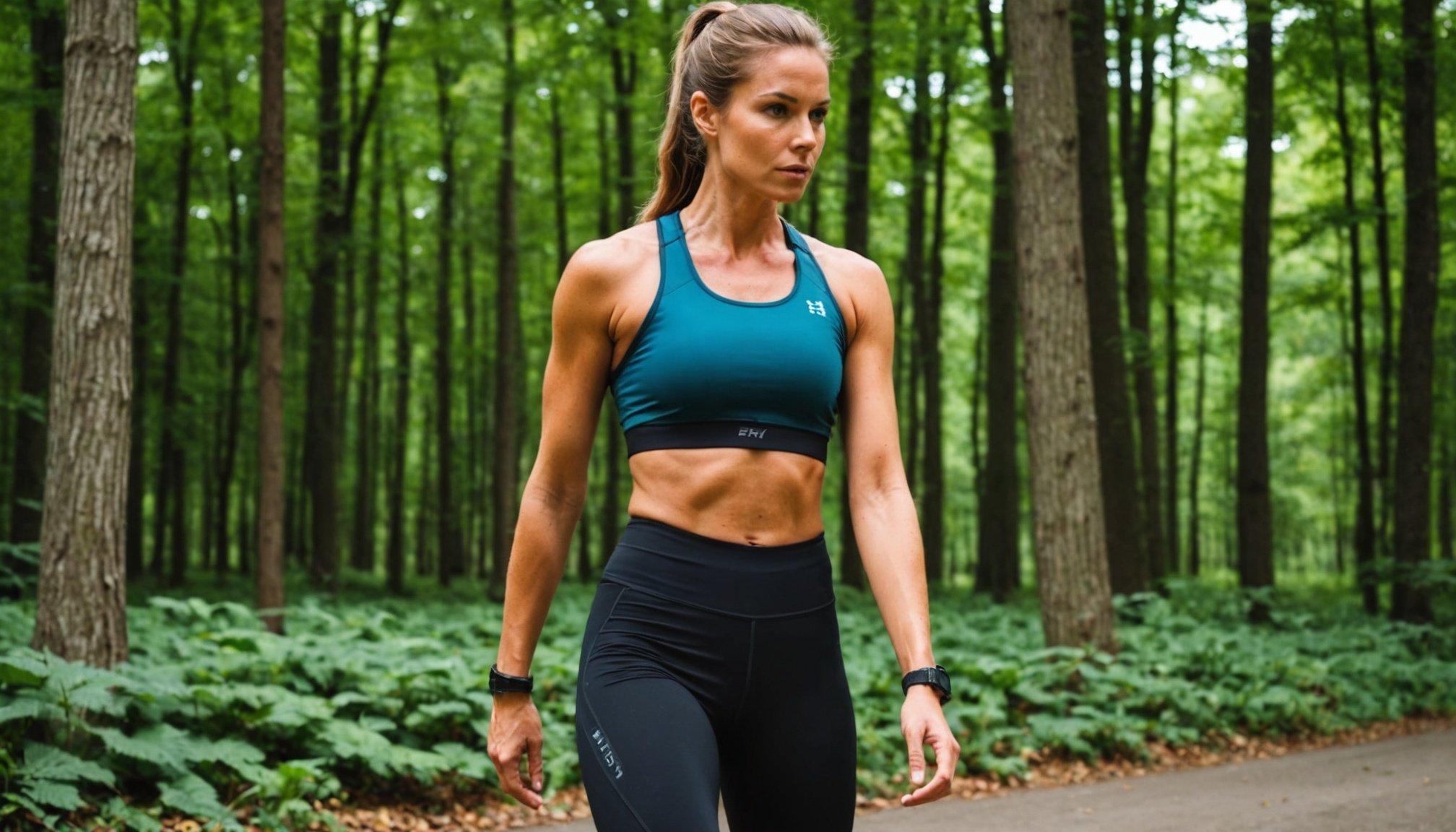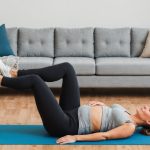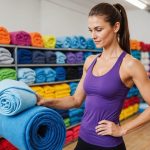Choosing sustainable workout gear is more than a trend; it's a commitment to our planet's future. Eco-friendly fabrics play a key role in reducing your carbon footprint while enjoying your fitness routine. This guide delves into the top materials available in the UK, ensuring you make informed choices that benefit both your performance and the environment. Discover practical options that not only feel good but align with your values. Let's explore how eco-conscious decisions can transform your workout wardrobe sustainably.
Overview of Eco-Friendly Fabrics
Exploring sustainable alternatives in workout gear.
Also read : Chic Dress Styles Perfect for a UK Polo Match: Your Ultimate Guide
Definition and Importance
Eco-friendly fabrics are materials designed with minimal impact on the environment. They are crafted from sustainable materials that reduce waste and conserve resources. These fabrics play a crucial role in promoting environmental responsibility, particularly in industries like fashion and fitness apparel.
Sustainable Materials in Workout Gear
Workout gear often incorporates sustainable materials such as organic cotton, bamboo, and recycled polyester. These materials are chosen for their durability and reduced environmental footprint. For instance, organic cotton is grown without harmful pesticides, while recycled polyester repurposes plastic waste, reducing the need for new resources.
In the same genre : Ultimate Style Guide: Key Fashion Must-Haves for University Lectures in Cambridge
Benefits of Eco-Friendly Fabrics
Using eco-friendly fabrics in fitness apparel offers numerous advantages:
- Environmental Impact: Reduces pollution and conserves water.
- Comfort: Provides breathability and moisture-wicking properties.
- Durability: Ensures long-lasting wear, reducing the frequency of replacements.
A quote from a sustainability expert highlights, "Choosing eco-friendly fabrics is a step towards a healthier planet and a more conscious lifestyle."
By opting for sustainable materials, consumers can support ethical practices and contribute to a more sustainable future. These choices not only benefit the planet but also enhance the quality and performance of workout gear.
Types of Eco-Friendly Fabrics
Discover the sustainable materials revolutionizing workout gear.
Organic Cotton
Organic cotton is a standout among eco-friendly fabrics. It is cultivated without the use of harmful pesticides, making it a healthier choice for both the environment and the wearer. This fabric is renowned for its softness and breathability, providing comfort during intense workouts. Additionally, its cultivation conserves water and supports biodiversity, aligning with sustainable practices.
Recycled Polyester
Recycled polyester is another prominent player in the realm of sustainable workout materials. By repurposing plastic waste, it significantly reduces the demand for virgin resources. This process not only decreases landfill waste but also limits the carbon footprint associated with traditional polyester production. The durability of recycled polyester ensures longevity, making it an ideal choice for activewear.
Tencel
Tencel is a cutting-edge fabric derived from sustainably sourced wood pulp. It excels in moisture-wicking properties, keeping the skin dry and comfortable during physical activities. Tencel's production process is environmentally friendly, utilizing closed-loop systems that recycle water and solvents. Its softness and strength make it a preferred option in eco-friendly fabrics for workout gear.
These sustainable workout materials not only offer environmental benefits but also enhance performance and comfort, encouraging consumers to make informed and eco-conscious choices.
Sustainability Credentials of Fabrics
Exploring the standards that define eco-friendly materials.
Certification Standards
Understanding fabric sustainability involves recognizing various eco-credentials. Certifications like GOTS (Global Organic Textile Standard) and OEKO-TEX play a pivotal role. GOTS ensures that textiles are organic from harvesting to labeling. Meanwhile, OEKO-TEX assesses harmful substances, guaranteeing consumer safety. These standards offer a framework for evaluating the sustainability of fabrics.
Comparison Across Fabrics
The sustainability credentials of fabrics vary significantly. Organic cotton, with GOTS certification, assures minimal environmental impact. Recycled polyester, often assessed by OEKO-TEX, confirms the absence of harmful chemicals. The comparison highlights how different fabrics meet distinct eco-credentials. This allows consumers to make informed decisions based on their environmental priorities.
Importance of Transparency
Transparency in sourcing materials is crucial for authentic fabric sustainability. Brands are increasingly required to disclose their supply chain processes. This openness builds trust and assures consumers of the eco-credentials of their purchases. As a sustainability expert notes, "Transparency is the backbone of genuine eco-friendly practices."
By understanding these certification standards, consumers can better navigate the complex landscape of sustainable fabrics, ensuring their choices align with their environmental values.
Benefits of Using Eco-Friendly Fabrics for Workout Gear
Exploring the advantages of sustainable materials in fitness apparel.
Environmental Benefits
Choosing eco-friendly workout gear significantly reduces the environmental impact. Sustainable fabrics like organic cotton and recycled polyester conserve resources and minimize pollution. By opting for these materials, consumers actively contribute to reducing waste and promoting a cleaner planet. This choice not only supports the environment but also encourages the fashion industry to adopt more sustainable practices.
Health Benefits
The use of non-toxic fabrics in eco-friendly workout gear offers substantial health advantages. Unlike conventional materials, these fabrics are free from harmful chemicals and pesticides, reducing the risk of skin irritation and allergies. This ensures a safer and more comfortable workout experience, allowing individuals to focus on their fitness goals without compromising their health.
Durability and Performance
Eco-friendly fabrics are known for their durability and enhanced performance. They are designed to withstand rigorous activities, providing long-lasting wear that reduces the need for frequent replacements. This durability is complemented by superior moisture-wicking properties, ensuring comfort and breathability during workouts. By investing in sustainable fabrics, consumers benefit from high-quality gear that supports their active lifestyle.
- Environmental Impact: Reduced pollution
- Health Safety: Non-toxic materials
- Longevity: Durable and reliable
These benefits underscore the value of choosing eco-friendly workout gear, making it a wise and responsible investment.
How to Choose Sustainable Workout Gear
Guidance for selecting eco-friendly workout apparel.
Key Factors to Consider
When choosing sustainable gear, focus on the materials and production processes. Look for eco-friendly workout apparel made from organic cotton, recycled polyester, or Tencel. These materials ensure a reduced environmental impact and superior comfort. Evaluate the durability and performance of the gear, as these factors contribute to longer-lasting wear and less frequent replacements.
Researching Brands and Practices
Investigating a brand's sustainability practices is crucial. Check for transparency in their supply chain and certifications like GOTS or OEKO-TEX. These certifications guarantee that the eco-friendly workout apparel meets specific environmental and safety standards. A quote from a sustainability advocate emphasizes, "Informed consumers drive brands towards more sustainable practices."
Tips for Evaluating Fabric Sustainability
- Read Labels: Look for sustainability certifications.
- Assess Durability: High-quality materials ensure longevity.
- Check Brand Ethics: Research brand commitments to sustainability.
Choosing sustainable gear involves a commitment to supporting ethical practices and reducing environmental impact. By focusing on these key factors, consumers can make informed decisions that align with their values and promote a healthier planet. This approach not only benefits the environment but also enhances the quality and performance of eco-friendly workout apparel.
Impact of Eco-Friendly Fabrics on the Environment
Analyzing the environmental benefits of sustainable materials.
Carbon Footprint
The carbon footprint of eco-friendly fabrics is notably lower compared to traditional materials. Conventional fabric production often relies on fossil fuels, contributing to greenhouse gas emissions. In contrast, eco-friendly fabrics like organic cotton and recycled polyester utilize renewable resources and energy-efficient processes, significantly reducing carbon emissions.
Water Usage
Water consumption is a critical factor in fabric production. Traditional textiles, particularly cotton, require vast amounts of water, exacerbating scarcity issues. Eco-friendly fabrics address this by employing sustainable practices. For instance, organic cotton farming uses rainwater harvesting, while Tencel production involves closed-loop systems that recycle water. These approaches minimize water usage, preserving this vital resource.
Waste Reduction
Sustainable practices in fabric production lead to substantial waste reduction. Traditional methods often generate excessive waste, contributing to environmental degradation. However, eco-friendly fabrics like recycled polyester transform waste into valuable resources, diverting plastic from landfills. This not only conserves materials but also promotes a circular economy.
- Carbon Emissions: Lower in eco-friendly production
- Water Conservation: Efficient use and recycling
- Waste Management: Reduced through recycling initiatives
By focusing on these aspects, consumers can appreciate the profound environmental impact of choosing eco-friendly fabrics.
Popular Brands Using Eco-Friendly Fabrics in the UK
Discover sustainable workout apparel brands making a difference.
Leading Brands in the UK Market
The UK market boasts a variety of eco-friendly brands dedicated to sustainable workout apparel. Notable names include BAM, known for its bamboo-based clothing, and Patagonia, which emphasizes recycled polyester. These brands prioritize sustainability, ensuring their products have minimal environmental impact.
Brands Prioritizing Sustainability
Several sustainable workout apparel brands in the UK have committed to eco-conscious practices. Finisterre stands out with its use of organic cotton and transparency in sourcing. People Tree is another leader, focusing on fair trade and GOTS-certified materials. These brands not only offer high-quality products but also contribute positively to the environment.
Consumer Reviews and Brand Reputation
Consumer reviews highlight the appeal of these eco-friendly brands. Customers praise BAM for comfort and sustainability. Patagonia is lauded for its durable and eco-conscious designs. Here's a snapshot of consumer sentiments:
- BAM: "Incredibly comfortable and sustainable."
- Patagonia: "Durable and eco-friendly."
- Finisterre: "Ethical and stylish."
These sustainable workout apparel brands have built strong reputations, appealing to environmentally conscious consumers. By choosing these brands, individuals support ethical practices and enjoy high-quality, eco-friendly products.
Where to Purchase Eco-Friendly Workout Gear in the UK
Discover where to buy sustainable workout apparel.
Online and Physical Stores
Finding sustainable workout gear in the UK is increasingly accessible with numerous online and physical stores. Patagonia and BAM offer a wide range of eco-friendly apparel through their websites, emphasizing recycled polyester and bamboo-based clothing. For those who prefer in-store shopping, Finisterre and People Tree have physical locations where consumers can explore organic cotton options.
Key Features to Look For
When purchasing eco-friendly workout gear, it is essential to consider key features such as sustainability certifications like GOTS or OEKO-TEX. These ensure that the apparel meets environmental and safety standards. Durability and performance are also crucial, as they guarantee long-lasting wear and comfort. A sustainability advocate notes, "Choosing certified products supports ethical practices and quality."
Recommendations for Specific Fabrics
For those seeking specific eco-friendly fabrics, Tencel is available at People Tree, known for its moisture-wicking properties. Recycled polyester can be found at Patagonia, ideal for durable activewear. Organic cotton options are widely available at Finisterre, offering softness and breathability.
- Online Stores: Patagonia, BAM
- Physical Stores: Finisterre, People Tree
- Certifications: GOTS, OEKO-TEX
This diverse selection ensures consumers can easily find sustainable workout gear that aligns with their values and needs.
Case Studies of Eco-Friendly Fabric Use
Analyzing successful implementations of sustainable practices.
Examples of Successful Brands
Several notable brands have effectively integrated eco-friendly fabrics into their products, setting benchmarks in sustainable practices. Patagonia exemplifies this by using recycled polyester in their activewear, significantly reducing their carbon footprint. BAM has also made strides with bamboo-based clothing, highlighting the versatility of eco-friendly fabrics.
Impact Stories from Consumers
Consumers who have transitioned to eco-friendly fabrics report positive experiences. A fitness enthusiast shared, "Switching to sustainable practices has not only improved my workout comfort but also aligned my lifestyle with my environmental values." These stories underscore the tangible benefits of choosing sustainable materials.
Lessons Learned from Brands
Brands prioritizing sustainable practices have learned valuable lessons. Finisterre, for instance, emphasizes transparency in their supply chain, fostering trust and consumer loyalty. Key insights include:
- Consumer Demand: Growing interest in sustainability
- Transparency: Essential for building trust
- Innovation: Drives product development
These case studies illustrate how brands successfully implement eco-friendly fabrics, benefiting both their business and the environment. Through these examples, other companies can learn and adopt similar sustainable practices.
Future Trends in Eco-Friendly Workout Fabrics
Exploring the innovations shaping sustainable fitness apparel.
Innovations in Eco-Friendly Fabric Technology
The future of sustainable fabrics is marked by exciting innovations. Scientists are developing bio-based materials that decompose naturally, minimizing environmental impact. For instance, fabrics made from algae and fungi are gaining attention for their biodegradability and strength. These advancements promise to revolutionize the fitness industry, offering eco-friendly options without compromising performance.
Predictions for Sustainable Fashion in the Fitness Industry
The eco-friendly trends in workout gear are expected to grow. As consumer awareness rises, brands are investing in sustainable practices and materials. This shift is predicted to lead to a surge in demand for eco-friendly workout fabrics. Experts foresee a future where sustainable options become the norm, driven by both innovation and consumer activism.
Importance of Consumer Awareness and Activism
Consumer awareness plays a crucial role in the future of sustainable fabrics. Educated consumers demand transparency and eco-friendly trends in the products they purchase. A sustainability expert notes, "Consumer activism is a powerful force for change, pushing brands towards more responsible practices."
- Bio-Based Materials: Algae, fungi
- Consumer Demand: Growing interest
- Innovation: Key to progress
By staying informed, consumers can drive the adoption of eco-friendly workout fabrics, ensuring a sustainable future for the fitness industry.











